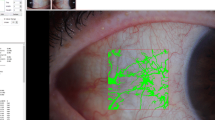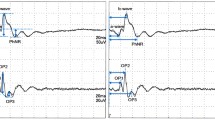Abstract
In brown-eyed and blue-eyed rabbits, irises treated with argon laser photomydriasis (ALP) were studied by using fluorescein angiography and by evaluating the aqueous humor protein concentration. The following results were obtained.
Immediately after ALP, a breakdown of the blood-aqueous barrier is demonstrated by a marked influx of fluorescein into the ciliary processes and into the anterior and posterior chambers. The dye flow into the aqueous humor decreases to normal values within 3 days. There is no fluorescein leakage from laser impacts themselves. Peripupillary capillary loops are permanently occluded, but in a few cases, recanalization occurs. Neovascularization did not occur during 56 days of observation.
ALP initially leads to a six- to eightfold increase in normal aqueous humor protein concentration, which decays to normal values within 3 days.
Similar content being viewed by others
References
Harris, L.S., Toyofuku, H., Shimmyo, M.: Fluorescein iris angiography in the albino rabbit. Ann. Ophthalmol. 88, 193–195 (1972)
James, W.A., de Roeth, A., Forbes, M., L'Esperance, F.A.: Argon laser photomydriasis. Am. J. Ophthalmol. 81, 62–70 (1976)
L'Esperance, F., James, W.A.: Argon laser photocoagulation of iris abnormalities. Trans. Am. Acad. Ophthalmol. Otolaryngol. 79, 321–339 (1975)
Müller-Bardorff, G., Müller-Bardorff, E., Mertz, M., Denffer, H. v., Mertz-Winter, G.: Proteinkonzentration im Kammerwasser des Kaninchens nach Laserkoagulation der Iris. Klin. Monatsbl. Augenheilkund. 172, 866–871 (1978)
Ostle, B., Meusing, W.: Statistics in research, 3rd ed. p. 312. Ames: Iowa State University Press 1975
Theodossiadis, G.: Management of aphakic pupillary block. A new argon laser approach. Adv. Ophthalmol. 34, 177–183 (1977)
Unger, W.G., Bass, M.S.: Prostaglandin and nerve-mediated response of the rabbit eye to argon laser irradiation of the iris. Ophthalmologica 175, 153–158 (1977)
Unger, W.G., Perkins, E.S., Bass, M.S.: The response of the rabbit eye to laser irradiation of the iris. Exp. Eye Res. 19, 367–377 (1974)
Unger, W.G., Brown, N., Edwards, J.: Response of the human eye to laser irradiation of the iris. Br. J. Ophthalmol. 61, 148–153 (1977)
Author information
Authors and Affiliations
Rights and permissions
About this article
Cite this article
Denffer, H.v., Erhardt, W. & Neiß, A. Fluorescein angiography and changes in aqueous humor protein after argon laser photomydriasis in rabbits. Albrecht von Graefes Arch. Klin. Ophthalmol. 211, 155–164 (1979). https://doi.org/10.1007/BF00410139
Received:
Issue Date:
DOI: https://doi.org/10.1007/BF00410139




